【Netty】02-入门
二. Netty 入门
1. 概述
1.1 Netty 是什么?
Netty is an asynchronous event-driven network application framework
for rapid development of maintainable high performance protocol servers & clients.
Netty 是一个异步的、基于事件驱动的网络应用框架,用于快速开发可维护、高性能的网络服务器和客户端
1.2 Netty 的作者
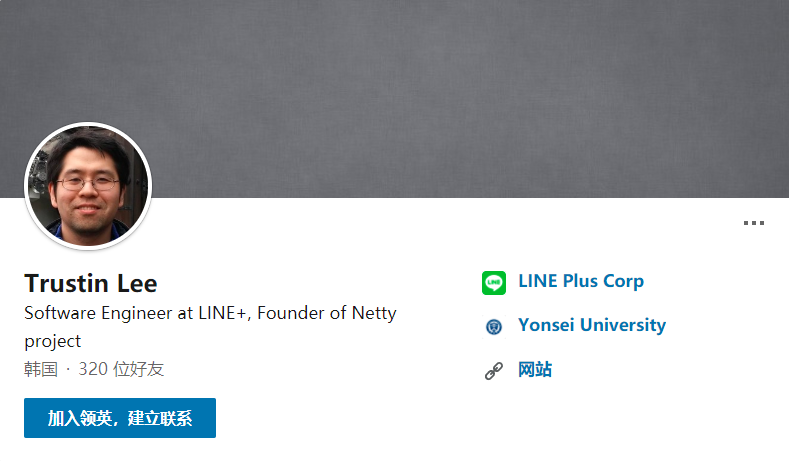
他还是另一个著名网络应用框架 Mina 的重要贡献者
1.3 Netty 的地位
Netty 在 Java 网络应用框架中的地位就好比:Spring 框架在 JavaEE 开发中的地位
以下的框架都使用了 Netty,因为它们有网络通信需求!
- Cassandra - nosql 数据库
- Spark - 大数据分布式计算框架
- Hadoop - 大数据分布式存储框架
- RocketMQ - ali 开源的消息队列
- ElasticSearch - 搜索引擎
- gRPC - rpc 框架
- Dubbo - rpc 框架
- Spring 5.x - flux api 完全抛弃了 tomcat ,使用 netty 作为服务器端
- Zookeeper - 分布式协调框架
1.4 Netty 的优势
- Netty vs NIO,工作量大,bug 多
- 需要自己构建协议
- 解决 TCP 传输问题,如粘包、半包
- epoll 空轮询导致 CPU 100%
- 对 API 进行增强,使之更易用,如 FastThreadLocal => ThreadLocal,ByteBuf => ByteBuffer
- Netty vs 其它网络应用框架
- Mina 由 apache 维护,将来 3.x 版本可能会有较大重构,破坏 API 向下兼容性,Netty 的开发迭代更迅速,API 更简洁、文档更优秀
- 久经考验,16年,Netty 版本
- 2.x 2004
- 3.x 2008
- 4.x 2013
- 5.x 已废弃(没有明显的性能提升,维护成本高)
2. Hello World
2.1 目标
开发一个简单的服务器端和客户端
- 客户端向服务器端发送 hello, world
- 服务器仅接收,不返回
加入依赖
<dependency>
<groupId>io.netty</groupId>
<artifactId>netty-all</artifactId>
<version>4.1.39.Final</version>
</dependency>
2.2 服务器端
new ServerBootstrap()
.group(new NioEventLoopGroup()) // 1
.channel(NioServerSocketChannel.class) // 2
.childHandler(new ChannelInitializer<NioSocketChannel>() { // 3
protected void initChannel(NioSocketChannel ch) {
ch.pipeline().addLast(new StringDecoder()); // 5
ch.pipeline().addLast(new SimpleChannelInboundHandler<String>() { // 6
@Override
protected void channelRead0(ChannelHandlerContext ctx, String msg) {
System.out.println(msg);
}
});
}
})
.bind(8080); // 4
代码解读
1 处,创建 NioEventLoopGroup,可以简单理解为
线程池 + Selector后面会详细展开2 处,选择服务 Scoket 实现类,其中 NioServerSocketChannel 表示基于 NIO 的服务器端实现,其它实现还有

3 处,为啥方法叫 childHandler,是接下来添加的处理器都是给 SocketChannel 用的,而不是给 ServerSocketChannel。ChannelInitializer 处理器(仅执行一次),它的作用是待客户端 SocketChannel 建立连接后,执行 initChannel 以便添加更多的处理器
4 处,ServerSocketChannel 绑定的监听端口
5 处,SocketChannel 的处理器,解码 ByteBuf => String
6 处,SocketChannel 的业务处理器,使用上一个处理器的处理结果
2.3 客户端
new Bootstrap()
.group(new NioEventLoopGroup()) // 1
.channel(NioSocketChannel.class) // 2
.handler(new ChannelInitializer<Channel>() { // 3
@Override
protected void initChannel(Channel ch) {
ch.pipeline().addLast(new StringEncoder()); // 8
}
})
.connect("127.0.0.1", 8080) // 4
.sync() // 5
.channel() // 6
.writeAndFlush(new Date() + ": hello world!"); // 7
代码解读
1 处,创建 NioEventLoopGroup,同 Server
2 处,选择客户 Socket 实现类,NioSocketChannel 表示基于 NIO 的客户端实现,其它实现还有

- 3 处,添加 SocketChannel 的处理器,ChannelInitializer 处理器(仅执行一次),它的作用是待客户端 SocketChannel 建立连接后,执行 initChannel 以便添加更多的处理器
- 4 处,指定要连接的服务器和端口
- 5 处,Netty 中很多方法都是异步的,如 connect,这时需要使用 sync 方法等待 connect 建立连接完毕
- 6 处,获取 channel 对象,它即为通道抽象,可以进行数据读写操作
- 7 处,写入消息并清空缓冲区
- 8 处,消息会经过通道 handler 处理,这里是将 String => ByteBuf 发出
- 数据经过网络传输,到达服务器端,服务器端 5 和 6 处的 handler 先后被触发,走完一个流程
2.4 流程梳理
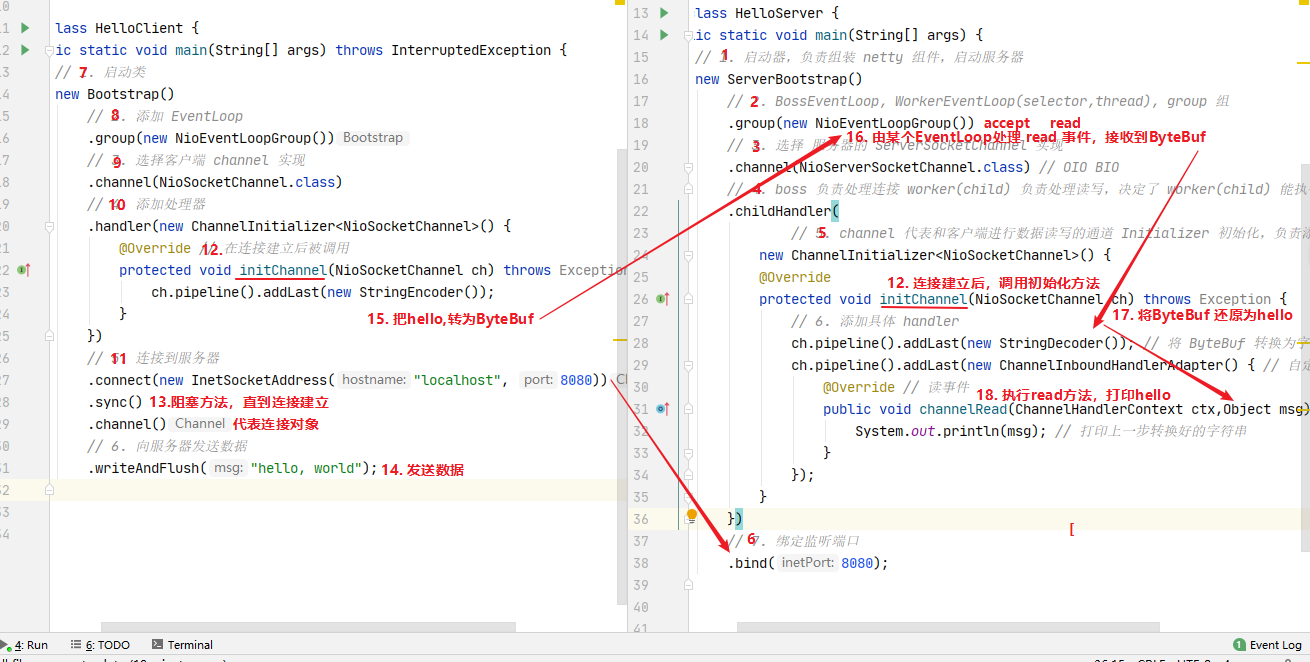
//HelloServer
package cn.itcast.netty.c2;
import io.netty.bootstrap.ServerBootstrap;
import io.netty.channel.ChannelHandlerContext;
import io.netty.channel.ChannelInboundHandlerAdapter;
import io.netty.channel.ChannelInitializer;
import io.netty.channel.nio.NioEventLoopGroup;
import io.netty.channel.socket.nio.NioServerSocketChannel;
import io.netty.channel.socket.nio.NioSocketChannel;
import io.netty.handler.codec.string.StringDecoder;
import io.netty.handler.logging.LoggingHandler;
public class HelloServer {
public static void main(String[] args) {
// 1. 启动器,负责组装 netty 组件,启动服务器
new ServerBootstrap()
// 2. BossEventLoop, WorkerEventLoop(selector,thread), group 组
.group(new NioEventLoopGroup())
// 3. 选择 服务器的 ServerSocketChannel 实现
.channel(NioServerSocketChannel.class) // OIO BIO
// 4. boss 负责处理连接 worker(child) 负责处理读写,决定了 worker(child) 能执行哪些操作(handler)
.childHandler(
// 5. channel 代表和客户端进行数据读写的通道 Initializer 初始化,负责添加别的 handler
new ChannelInitializer<NioSocketChannel>() {
@Override
protected void initChannel(NioSocketChannel ch) throws Exception {
// 6. 添加具体 handler
ch.pipeline().addLast(new LoggingHandler());
ch.pipeline().addLast(new StringDecoder()); // 将 ByteBuf 转换为字符串
ch.pipeline().addLast(new ChannelInboundHandlerAdapter() { // 自定义 handler
@Override // 读事件
public void channelRead(ChannelHandlerContext ctx,Object msg) throws Exception {
System.out.println(msg); // 打印上一步转换好的字符串
}
});
}
})
// 7. 绑定监听端口
.bind(8080);
}
}
//HelloClient
package cn.itcast.netty.c2;
import io.netty.bootstrap.Bootstrap;
import io.netty.channel.ChannelInitializer;
import io.netty.channel.nio.NioEventLoopGroup;
import io.netty.channel.socket.nio.NioSocketChannel;
import io.netty.handler.codec.string.StringEncoder;
import java.net.InetSocketAddress;
public class HelloClient {
public static void main(String[] args) throws InterruptedException {
// 1. 启动类
new Bootstrap()
// 2. 添加 EventLoop
.group(new NioEventLoopGroup())
// 3. 选择客户端 channel 实现
.channel(NioSocketChannel.class)
// 4. 添加处理器
.handler(new ChannelInitializer<NioSocketChannel>() {
@Override // 在连接建立后被调用
protected void initChannel(NioSocketChannel ch) throws Exception {
ch.pipeline().addLast(new StringEncoder());
}
})
// 5. 连接到服务器
.connect(new InetSocketAddress("localhost", 8080))
.sync()
.channel()
// 6. 向服务器发送数据
.writeAndFlush("hello, world");
}
}
提示
一开始需要树立正确的观念
- 把 channel 理解为数据的通道
- 把 msg 理解为流动的数据,最开始输入是 ByteBuf,但经过 pipeline 的加工,会变成其它类型对象,最后输出又变成 ByteBuf
- 把 handler 理解为数据的处理工序
- 工序有多道,合在一起就是 pipeline,pipeline 负责发布事件(读、读取完成...)传播给每个 handler, handler 对自己感兴趣的事件进行处理(重写了相应事件处理方法)
- handler 分 Inbound 和 Outbound 两类
- 把 eventLoop 理解为处理数据的工人
- 工人可以管理多个 channel 的 io 操作,并且一旦工人负责了某个 channel,就要负责到底(绑定)
- 工人既可以执行 io 操作,也可以进行任务处理,每位工人有任务队列,队列里可以堆放多个 channel 的待处理任务,任务分为普通任务、定时任务
- 工人按照 pipeline 顺序,依次按照 handler 的规划(代码)处理数据,可以为每道工序指定不同的工人
3. 组件
3.1 EventLoop
事件循环对象
EventLoop 本质是一个单线程执行器(同时维护了一个 Selector),里面有 run 方法处理 Channel 上源源不断的 io 事件。
它的继承关系比较复杂
- 一条线是继承自 j.u.c.ScheduledExecutorService 因此包含了线程池中所有的方法
- 另一条线是继承自 netty 自己的 OrderedEventExecutor,
- 提供了 boolean inEventLoop(Thread thread) 方法判断一个线程是否属于此 EventLoop
- 提供了 parent 方法来看看自己属于哪个 EventLoopGroup
事件循环组
EventLoopGroup 是一组 EventLoop,Channel 一般会调用 EventLoopGroup 的 register 方法来绑定其中一个 EventLoop,后续这个 Channel 上的 io 事件都由此 EventLoop 来处理(保证了 io 事件处理时的线程安全)
- 继承自 netty 自己的 EventExecutorGroup
- 实现了 Iterable 接口提供遍历 EventLoop 的能力
- 另有 next 方法获取集合中下一个 EventLoop
以一个简单的实现为例:
// 内部创建了两个 EventLoop, 每个 EventLoop 维护一个线程
DefaultEventLoopGroup group = new DefaultEventLoopGroup(2);
System.out.println(group.next());
System.out.println(group.next());
System.out.println(group.next());
输出
io.netty.channel.DefaultEventLoop@60f82f98
io.netty.channel.DefaultEventLoop@35f983a6
io.netty.channel.DefaultEventLoop@60f82f98
也可以使用 for 循环
DefaultEventLoopGroup group = new DefaultEventLoopGroup(2);
for (EventExecutor eventLoop : group) {
System.out.println(eventLoop);
}
输出
io.netty.channel.DefaultEventLoop@60f82f98
io.netty.channel.DefaultEventLoop@35f983a6
优雅关闭
优雅关闭 shutdownGracefully 方法。该方法会首先切换 EventLoopGroup 到关闭状态从而拒绝新的任务的加入,然后在任务队列的任务都处理完成后,停止线程的运行。从而确保整体应用是在正常有序的状态下退出的
演示 NioEventLoop 处理 io 事件
服务器端两个 nio worker 工人
new ServerBootstrap()
.group(new NioEventLoopGroup(1), new NioEventLoopGroup(2))
.channel(NioServerSocketChannel.class)
.childHandler(new ChannelInitializer<NioSocketChannel>() {
@Override
protected void initChannel(NioSocketChannel ch) {
ch.pipeline().addLast(new ChannelInboundHandlerAdapter() {
@Override
public void channelRead(ChannelHandlerContext ctx, Object msg) {
ByteBuf byteBuf = msg instanceof ByteBuf ? ((ByteBuf) msg) : null;
if (byteBuf != null) {
byte[] buf = new byte[16];
ByteBuf len = byteBuf.readBytes(buf, 0, byteBuf.readableBytes());
log.debug(new String(buf));
}
}
});
}
}).bind(8080).sync();
客户端,启动三次,分别修改发送字符串为 zhangsan(第一次),lisi(第二次),wangwu(第三次)
public static void main(String[] args) throws InterruptedException {
Channel channel = new Bootstrap()
.group(new NioEventLoopGroup(1))
.handler(new ChannelInitializer<NioSocketChannel>() {
@Override
protected void initChannel(NioSocketChannel ch) throws Exception {
System.out.println("init...");
ch.pipeline().addLast(new LoggingHandler(LogLevel.DEBUG));
}
})
.channel(NioSocketChannel.class).connect("localhost", 8080)
.sync()
.channel();
channel.writeAndFlush(ByteBufAllocator.DEFAULT.buffer().writeBytes("wangwu".getBytes()));
Thread.sleep(2000);
channel.writeAndFlush(ByteBufAllocator.DEFAULT.buffer().writeBytes("wangwu".getBytes()));
最后输出
22:03:34 [DEBUG] [nioEventLoopGroup-3-1] c.i.o.EventLoopTest - zhangsan
22:03:36 [DEBUG] [nioEventLoopGroup-3-1] c.i.o.EventLoopTest - zhangsan
22:05:36 [DEBUG] [nioEventLoopGroup-3-2] c.i.o.EventLoopTest - lisi
22:05:38 [DEBUG] [nioEventLoopGroup-3-2] c.i.o.EventLoopTest - lisi
22:06:09 [DEBUG] [nioEventLoopGroup-3-1] c.i.o.EventLoopTest - wangwu
22:06:11 [DEBUG] [nioEventLoopGroup-3-1] c.i.o.EventLoopTest - wangwu
可以看到两个线程轮流处理 channel,但线程与 channel 之间进行了绑定
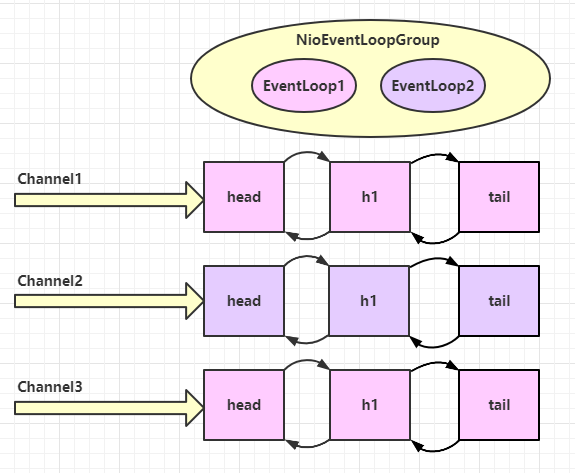
再增加两个非 nio 工人
//非nio工人线程
DefaultEventLoopGroup normalWorkers = new DefaultEventLoopGroup(2);
new ServerBootstrap()
.group(new NioEventLoopGroup(1), new NioEventLoopGroup(2))
.channel(NioServerSocketChannel.class)
.childHandler(new ChannelInitializer<NioSocketChannel>() {
@Override
protected void initChannel(NioSocketChannel ch) {
ch.pipeline().addLast(new LoggingHandler(LogLevel.DEBUG));
//用normalWorkers线程池
ch.pipeline().addLast(normalWorkers,"myhandler",
new ChannelInboundHandlerAdapter() {
@Override
public void channelRead(ChannelHandlerContext ctx, Object msg) {
ByteBuf byteBuf = msg instanceof ByteBuf ? ((ByteBuf) msg) : null;
if (byteBuf != null) {
byte[] buf = new byte[16];
ByteBuf len = byteBuf.readBytes(buf, 0, byteBuf.readableBytes());
log.debug(new String(buf));
}
}
});
}
}).bind(8080).sync();
客户端代码不变,启动三次,分别修改发送字符串为 zhangsan(第一次),lisi(第二次),wangwu(第三次)
输出
22:19:48 [DEBUG] [nioEventLoopGroup-4-1] i.n.h.l.LoggingHandler - [id: 0x251562d5, L:/127.0.0.1:8080 - R:/127.0.0.1:52588] REGISTERED
22:19:48 [DEBUG] [nioEventLoopGroup-4-1] i.n.h.l.LoggingHandler - [id: 0x251562d5, L:/127.0.0.1:8080 - R:/127.0.0.1:52588] ACTIVE
22:19:48 [DEBUG] [nioEventLoopGroup-4-1] i.n.h.l.LoggingHandler - [id: 0x251562d5, L:/127.0.0.1:8080 - R:/127.0.0.1:52588] READ: 8B
+-------------------------------------------------+
| 0 1 2 3 4 5 6 7 8 9 a b c d e f |
+--------+-------------------------------------------------+----------------+
|00000000| 7a 68 61 6e 67 73 61 6e |zhangsan |
+--------+-------------------------------------------------+----------------+
22:19:48 [DEBUG] [nioEventLoopGroup-4-1] i.n.h.l.LoggingHandler - [id: 0x251562d5, L:/127.0.0.1:8080 - R:/127.0.0.1:52588] READ COMPLETE
22:19:48 [DEBUG] [defaultEventLoopGroup-2-1] c.i.o.EventLoopTest - zhangsan
22:19:50 [DEBUG] [nioEventLoopGroup-4-1] i.n.h.l.LoggingHandler - [id: 0x251562d5, L:/127.0.0.1:8080 - R:/127.0.0.1:52588] READ: 8B
+-------------------------------------------------+
| 0 1 2 3 4 5 6 7 8 9 a b c d e f |
+--------+-------------------------------------------------+----------------+
|00000000| 7a 68 61 6e 67 73 61 6e |zhangsan |
+--------+-------------------------------------------------+----------------+
22:19:50 [DEBUG] [nioEventLoopGroup-4-1] i.n.h.l.LoggingHandler - [id: 0x251562d5, L:/127.0.0.1:8080 - R:/127.0.0.1:52588] READ COMPLETE
22:19:50 [DEBUG] [defaultEventLoopGroup-2-1] c.i.o.EventLoopTest - zhangsan
22:20:24 [DEBUG] [nioEventLoopGroup-4-2] i.n.h.l.LoggingHandler - [id: 0x94b2a840, L:/127.0.0.1:8080 - R:/127.0.0.1:52612] REGISTERED
22:20:24 [DEBUG] [nioEventLoopGroup-4-2] i.n.h.l.LoggingHandler - [id: 0x94b2a840, L:/127.0.0.1:8080 - R:/127.0.0.1:52612] ACTIVE
22:20:25 [DEBUG] [nioEventLoopGroup-4-2] i.n.h.l.LoggingHandler - [id: 0x94b2a840, L:/127.0.0.1:8080 - R:/127.0.0.1:52612] READ: 4B
+-------------------------------------------------+
| 0 1 2 3 4 5 6 7 8 9 a b c d e f |
+--------+-------------------------------------------------+----------------+
|00000000| 6c 69 73 69 |lisi |
+--------+-------------------------------------------------+----------------+
22:20:25 [DEBUG] [nioEventLoopGroup-4-2] i.n.h.l.LoggingHandler - [id: 0x94b2a840, L:/127.0.0.1:8080 - R:/127.0.0.1:52612] READ COMPLETE
22:20:25 [DEBUG] [defaultEventLoopGroup-2-2] c.i.o.EventLoopTest - lisi
22:20:27 [DEBUG] [nioEventLoopGroup-4-2] i.n.h.l.LoggingHandler - [id: 0x94b2a840, L:/127.0.0.1:8080 - R:/127.0.0.1:52612] READ: 4B
+-------------------------------------------------+
| 0 1 2 3 4 5 6 7 8 9 a b c d e f |
+--------+-------------------------------------------------+----------------+
|00000000| 6c 69 73 69 |lisi |
+--------+-------------------------------------------------+----------------+
22:20:27 [DEBUG] [nioEventLoopGroup-4-2] i.n.h.l.LoggingHandler - [id: 0x94b2a840, L:/127.0.0.1:8080 - R:/127.0.0.1:52612] READ COMPLETE
22:20:27 [DEBUG] [defaultEventLoopGroup-2-2] c.i.o.EventLoopTest - lisi
22:20:38 [DEBUG] [nioEventLoopGroup-4-1] i.n.h.l.LoggingHandler - [id: 0x79a26af9, L:/127.0.0.1:8080 - R:/127.0.0.1:52625] REGISTERED
22:20:38 [DEBUG] [nioEventLoopGroup-4-1] i.n.h.l.LoggingHandler - [id: 0x79a26af9, L:/127.0.0.1:8080 - R:/127.0.0.1:52625] ACTIVE
22:20:38 [DEBUG] [nioEventLoopGroup-4-1] i.n.h.l.LoggingHandler - [id: 0x79a26af9, L:/127.0.0.1:8080 - R:/127.0.0.1:52625] READ: 6B
+-------------------------------------------------+
| 0 1 2 3 4 5 6 7 8 9 a b c d e f |
+--------+-------------------------------------------------+----------------+
|00000000| 77 61 6e 67 77 75 |wangwu |
+--------+-------------------------------------------------+----------------+
22:20:38 [DEBUG] [nioEventLoopGroup-4-1] i.n.h.l.LoggingHandler - [id: 0x79a26af9, L:/127.0.0.1:8080 - R:/127.0.0.1:52625] READ COMPLETE
22:20:38 [DEBUG] [defaultEventLoopGroup-2-1] c.i.o.EventLoopTest - wangwu
22:20:40 [DEBUG] [nioEventLoopGroup-4-1] i.n.h.l.LoggingHandler - [id: 0x79a26af9, L:/127.0.0.1:8080 - R:/127.0.0.1:52625] READ: 6B
+-------------------------------------------------+
| 0 1 2 3 4 5 6 7 8 9 a b c d e f |
+--------+-------------------------------------------------+----------------+
|00000000| 77 61 6e 67 77 75 |wangwu |
+--------+-------------------------------------------------+----------------+
22:20:40 [DEBUG] [nioEventLoopGroup-4-1] i.n.h.l.LoggingHandler - [id: 0x79a26af9, L:/127.0.0.1:8080 - R:/127.0.0.1:52625] READ COMPLETE
22:20:40 [DEBUG] [defaultEventLoopGroup-2-1] c.i.o.EventLoopTest - wangwu
可以看到,nio 工人和 非 nio 工人也分别绑定了 channel(LoggingHandler 由 nio 工人执行,而我们自己的 handler 由非 nio 工人执行)
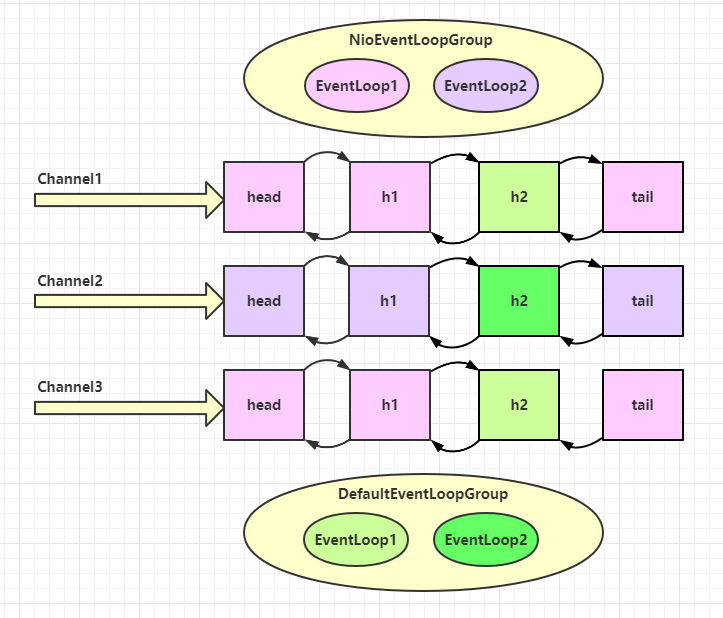
handler 执行中如何换人?
关键代码 io.netty.channel.AbstractChannelHandlerContext#invokeChannelRead()
Netty源码
static void invokeChannelRead(final AbstractChannelHandlerContext next, Object msg) {
final Object m = next.pipeline.touch(ObjectUtil.checkNotNull(msg, "msg"), next);
// 下一个 handler 的事件循环是否与当前的事件循环是同一个线程,其实就是下一个handler的EventLoop
EventExecutor executor = next.executor();
// 是,直接调用
if (executor.inEventLoop()) {
next.invokeChannelRead(m);
}
// 不是,将要执行的代码作为任务提交给下一个事件循环处理(换人)
else {
//executor是下一个handler的线程
//两个handler绑定的是否为同一个线程?如果是则直接调用,否则把要调用的代码放在一个任务对象(Runnable)里,交给下一个handler的线程来调用
executor.execute(new Runnable() {
@Override
public void run() {
next.invokeChannelRead(m);
}
});
}
}
- 如果两个 handler 绑定的是同一个线程,那么就直接调用
- 否则,把要调用的代码封装为一个任务对象,由下一个 handler 的线程来调用
演示 NioEventLoop 处理普通任务
NioEventLoop 除了可以处理 io 事件,同样可以向它提交普通任务
NioEventLoopGroup nioWorkers = new NioEventLoopGroup(2);
log.debug("server start...");
Thread.sleep(2000);
nioWorkers.execute(()->{
log.debug("normal task...");
});
输出
22:30:36 [DEBUG] [main] c.i.o.EventLoopTest2 - server start...
22:30:38 [DEBUG] [nioEventLoopGroup-2-1] c.i.o.EventLoopTest2 - normal task...
可以用来执行耗时较长的任务
演示 NioEventLoop 处理定时任务
NioEventLoopGroup nioWorkers = new NioEventLoopGroup(2);
log.debug("server start...");
Thread.sleep(2000);
nioWorkers.scheduleAtFixedRate(() -> {
log.debug("running...");
}, 0, 1, TimeUnit.SECONDS);
输出
22:35:15 [DEBUG] [main] c.i.o.EventLoopTest2 - server start...
22:35:17 [DEBUG] [nioEventLoopGroup-2-1] c.i.o.EventLoopTest2 - running...
22:35:18 [DEBUG] [nioEventLoopGroup-2-1] c.i.o.EventLoopTest2 - running...
22:35:19 [DEBUG] [nioEventLoopGroup-2-1] c.i.o.EventLoopTest2 - running...
22:35:20 [DEBUG] [nioEventLoopGroup-2-1] c.i.o.EventLoopTest2 - running...
...
可以用来执行定时任务
3.2 Channel
channel 的主要作用
- close() 可以用来关闭 channel
- closeFuture() 用来处理 channel 的关闭
- sync 方法作用是同步等待 channel 关闭
- 而 addListener 方法是异步等待 channel 关闭
- pipeline() 方法添加处理器
- write() 方法将数据写入
- writeAndFlush() 方法将数据写入并刷出
ChannelFuture
个人理解:ChannelFuture主要用于接收异步执行的结果,以及执行回调函数
这是刚才的客户端代码
new Bootstrap()
.group(new NioEventLoopGroup())
.channel(NioSocketChannel.class)
.handler(new ChannelInitializer<Channel>() {
@Override
protected void initChannel(Channel ch) {
ch.pipeline().addLast(new StringEncoder());
}
})
.connect("127.0.0.1", 8080)
.sync()
.channel()
.writeAndFlush(new Date() + ": hello world!");
现在把它拆开来看
ChannelFuture channelFuture = new Bootstrap()
.group(new NioEventLoopGroup())
.channel(NioSocketChannel.class)
.handler(new ChannelInitializer<Channel>() {
@Override
protected void initChannel(Channel ch) {
ch.pipeline().addLast(new StringEncoder());
}
})
.connect("127.0.0.1", 8080); // 1
//同步等待connect建立,再执行下一步
channelFuture.sync().channel().writeAndFlush(new Date() + ": hello world!");
- 1 处返回的是 ChannelFuture 对象,它的作用是利用 channel() 方法来获取 Channel 对象
注意 connect 方法是异步的,意味着不等连接建立,方法执行就返回了。因此 channelFuture 对象中不能【立刻】获得到正确的 Channel 对象
实验如下:
ChannelFuture channelFuture = new Bootstrap()
.group(new NioEventLoopGroup())
.channel(NioSocketChannel.class)
.handler(new ChannelInitializer<Channel>() {
@Override
protected void initChannel(Channel ch) {
ch.pipeline().addLast(new StringEncoder());
}
})
.connect("127.0.0.1", 8080);
System.out.println(channelFuture.channel()); // 1
channelFuture.sync(); // 2
System.out.println(channelFuture.channel()); // 3
- 执行到 1 时,连接未建立,打印
[id: 0x2e1884dd] - 执行到 2 时,sync 方法是同步等待连接建立完成
- 执行到 3 时,连接肯定建立了,打印
[id: 0x2e1884dd, L:/127.0.0.1:57191 - R:/127.0.0.1:8080]
除了用 sync 方法可以让异步操作同步以外,还可以使用回调的方式:
package cn.itcast.netty.c3;
import io.netty.bootstrap.Bootstrap;
import io.netty.channel.Channel;
import io.netty.channel.ChannelFuture;
import io.netty.channel.ChannelFutureListener;
import io.netty.channel.ChannelInitializer;
import io.netty.channel.nio.NioEventLoopGroup;
import io.netty.channel.socket.nio.NioSocketChannel;
import io.netty.handler.codec.string.StringEncoder;
import lombok.extern.slf4j.Slf4j;
import java.net.InetSocketAddress;
@Slf4j
public class EventLoopClient {
public static void main(String[] args) throws InterruptedException {
// 2. 带有 Future,Promise 的类型都是和异步方法配套使用,用来处理结果
ChannelFuture channelFuture = new Bootstrap()
.group(new NioEventLoopGroup())
.channel(NioSocketChannel.class)
.handler(new ChannelInitializer<NioSocketChannel>() {
@Override // 在连接建立后被调用
protected void initChannel(NioSocketChannel ch) throws Exception {
ch.pipeline().addLast(new StringEncoder());
}
})
// 1. 连接到服务器
// 异步非阻塞, main 发起了调用,真正执行 connect 是 nio 线程
.connect(new InetSocketAddress("localhost", 8080)); // 1s 秒后
// 2.1 使用 sync 方法同步处理结果
/*channelFuture.sync(); // 阻塞住当前线程,直到nio线程连接建立完毕
Channel channel = channelFuture.channel();
log.debug("{}", channel);
channel.writeAndFlush("hello, world");*/
// 2.2 使用 addListener(回调对象) 方法异步处理结果
channelFuture.addListener(new ChannelFutureListener() {
@Override
// 在 nio 线程连接建立好之后,会调用 operationComplete
public void operationComplete(ChannelFuture future) throws Exception {
Channel channel = future.channel();
log.debug("{}", channel);
channel.writeAndFlush("hello, world");
}
});
}
}
CloseFuture
@Slf4j
public class CloseFutureClient {
public static void main(String[] args) throws InterruptedException {
NioEventLoopGroup group new NioEventLoopGroup();
ChannelFuture channelFuture = new Bootstrap()
.group(group)
.channel(NioSocketChannel.class)
.handler(new ChannelInitializer<NioSocketChannel>() {
@Override // 在连接建立后被调用
protected void initChannel(NioSocketChannel ch) throws Exception {
ch.pipeline().addLast(new LoggingHandler(LogLevel.DEBUG));
ch.pipeline().addLast(new StringEncoder());
}
})
.connect(new InetSocketAddress("localhost", 8080));
Channel channel = channelFuture.sync().channel();
log.debug("{}", channel);
new Thread(()->{
Scanner scanner = new Scanner(System.in);
while (true) {
String line = scanner.nextLine();
if ("q".equals(line)) {
channel.close(); // close 异步操作 1s 之后
// log.debug("处理关闭之后的操作"); // 不能在这里善后
break;
}
channel.writeAndFlush(line);
}
}, "input").start();
// 获取 CloseFuture 对象, 1) 同步处理关闭, 2) 异步处理关闭
ChannelFuture closeFuture = channel.closeFuture();
/*log.debug("waiting close...");
closeFuture.sync();
log.debug("处理关闭之后的操作");*/
closeFuture.addListener(new ChannelFutureListener() {
@Override
public void operationComplete(ChannelFuture future) throws Exception {
log.debug("处理关闭之后的操作");
group.shutdownGracefully();
}
});
}
}
异步提升的是什么
疑问:为什么不在一个线程中去执行建立连接、去执行关闭 channel,那样不是也可以吗?非要用这么复杂的异步方式:比如一个线程发起建立连接,另一个线程去真正建立连接
笼统地回答:因为 netty 异步方式用了多线程、多线程就效率高。其实这些认识都比较片面,多线程和异步所提升的效率并不是所认为的
思考下面的场景,4 个医生给人看病,每个病人花费 20 分钟,而且医生看病的过程中是以病人为单位的,一个病人看完了,才能看下一个病人。假设病人源源不断地来,可以计算一下 4 个医生一天工作 8 小时,处理的病人总数是:4 * 8 * 3 = 96
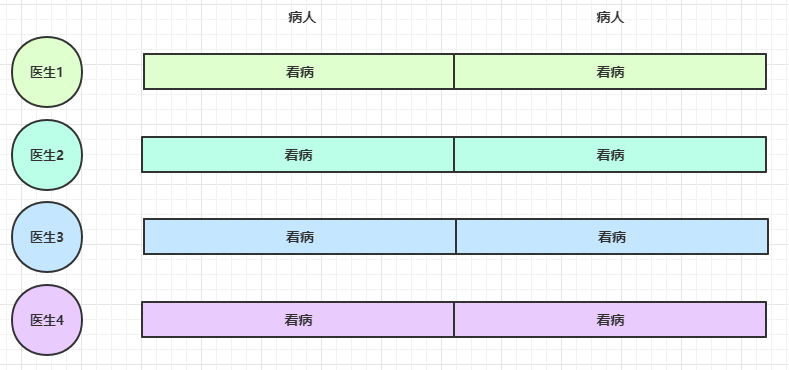
经研究发现,看病可以细分为四个步骤,经拆分后每个步骤需要 5 分钟,如下
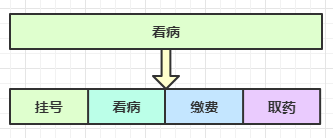
因此可以做如下优化,只有一开始,医生 2、3、4 分别要等待 5、10、15 分钟才能执行工作,但只要后续病人源源不断地来,他们就能够满负荷工作,并且处理病人的能力提高到了 4 * 8 * 12 效率几乎是原来的四倍
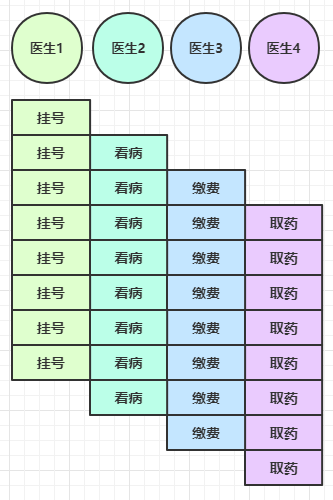
要点
- 单线程没法异步提高效率,必须配合多线程、多核 cpu 才能发挥异步的优势
- 异步并没有缩短响应时间,反而有所增加
- 合理进行任务拆分,也是利用异步的关键
3.3 Future & Promise
在异步处理时,经常用到这两个接口
首先要说明 netty 中的 Future 与 jdk 中的 Future 同名,但是是两个接口,netty 的 Future 继承自 jdk 的 Future,而 Promise 又对 netty Future 进行了扩展
- jdk Future 只能同步等待任务结束(或成功、或失败)才能得到结果
- netty Future 可以同步等待任务结束得到结果,也可以异步方式得到结果,但都是要等任务结束
- netty Promise 不仅有 netty Future 的功能,而且脱离了任务独立存在,只作为两个线程间传递结果的容器
| 功能/名称 | jdk Future | netty Future | Promise |
|---|---|---|---|
| cancel | 取消任务 | - | - |
| isCanceled | 任务是否取消 | - | - |
| isDone | 任务是否完成,不能区分成功失败 | - | - |
| get | 获取任务结果,阻塞等待 | - | - |
| getNow | - | 获取任务结果,非阻塞,还未产生结果时返回 null | - |
| await | - | 等待任务结束,如果任务失败,不会抛异常,而是通过 isSuccess 判断 | - |
| sync | - | 等待任务结束,如果任务失败,抛出异常 | - |
| isSuccess | - | 判断任务是否成功 | - |
| cause | - | 获取失败信息,非阻塞,如果没有失败,返回null | - |
| addLinstener | - | 添加回调,异步接收结果 | - |
| setSuccess | - | - | 设置成功结果 |
| setFailure | - | - | 设置失败结果 |
例1
同步处理任务成功
package cn.itcast.netty.c3;
import io.netty.channel.EventLoop;
import io.netty.channel.EventLoopGroup;
import io.netty.channel.nio.NioEventLoopGroup;
import io.netty.util.concurrent.DefaultPromise;
import lombok.extern.slf4j.Slf4j;
import java.util.concurrent.ExecutionException;
@Slf4j
public class TestNettyPromise {
public static void main(String[] args) throws ExecutionException, InterruptedException {
// 1. 准备 EventLoop 对象
EventLoop eventLoop = new NioEventLoopGroup().next();
// 2. 可以主动创建 promise, 结果容器
DefaultPromise<Integer> promise = new DefaultPromise<>(eventLoop);
new Thread(() -> {
// 3. 任意一个线程执行计算,计算完毕后向 promise 填充结果
log.debug("开始计算...");
try {
int i = 1 / 0;
Thread.sleep(1000);
promise.setSuccess(80);
} catch (Exception e) {
e.printStackTrace();
promise.setFailure(e);
}
}).start();
// 4. 调用get()方法,同步等待接收结果
log.debug("等待结果...");
log.debug("结果是: {}", promise.get());
}
}
输出
错误版(用1除以0),抛出异常:
java.lang.ArithmeticException: / by zero
at cn.itcast.netty.c3.TestNettyPromise.lambda$main$0(TestNettyPromise.java:22)
at java.lang.Thread.run(Thread.java:750)
Exception in thread "main" java.util.concurrent.ExecutionException: java.lang.ArithmeticException: / by zero
at io.netty.util.concurrent.AbstractFuture.get(AbstractFuture.java:41)
at cn.itcast.netty.c3.TestNettyPromise.main(TestNettyPromise.java:33)
Caused by: java.lang.ArithmeticException: / by zero
at cn.itcast.netty.c3.TestNettyPromise.lambda$main$0(TestNettyPromise.java:22)
at java.lang.Thread.run(Thread.java:750)
正确版:
16:13:31 [DEBUG] [main] c.i.n.c.TestNettyPromise - 等待结果...
16:13:31 [DEBUG] [Thread-0] c.i.n.c.TestNettyPromise - 开始计算...
16:13:32 [DEBUG] [main] c.i.n.c.TestNettyPromise - 结果是: 80
例2
异步处理任务成功
DefaultEventLoop eventExecutors = new DefaultEventLoop();
DefaultPromise<Integer> promise = new DefaultPromise<>(eventExecutors);
// 设置回调,异步接收结果
promise.addListener(future -> {
// 这里的 future 就是上面的 promise
log.debug("{}",future.getNow());
});
// 等待 1000 后设置成功结果
eventExecutors.execute(()->{
try {
Thread.sleep(1000);
} catch (InterruptedException e) {
e.printStackTrace();
}
log.debug("set success, {}",10);
promise.setSuccess(10);
});
log.debug("start...");
输出
11:49:30 [DEBUG] [main] c.i.o.DefaultPromiseTest2 - start...
11:49:31 [DEBUG] [defaultEventLoop-1-1] c.i.o.DefaultPromiseTest2 - set success, 10
11:49:31 [DEBUG] [defaultEventLoop-1-1] c.i.o.DefaultPromiseTest2 - 10
例3
同步处理任务失败 - sync & get
DefaultEventLoop eventExecutors = new DefaultEventLoop();
DefaultPromise<Integer> promise = new DefaultPromise<>(eventExecutors);
eventExecutors.execute(() -> {
try {
Thread.sleep(1000);
} catch (InterruptedException e) {
e.printStackTrace();
}
RuntimeException e = new RuntimeException("error...");
log.debug("set failure, {}", e.toString());
promise.setFailure(e);
});
log.debug("start...");
log.debug("{}", promise.getNow());
promise.get(); // sync() 也会出现异常,只是 get 会再用 ExecutionException 包一层异常
输出
12:11:07 [DEBUG] [main] c.i.o.DefaultPromiseTest2 - start...
12:11:07 [DEBUG] [main] c.i.o.DefaultPromiseTest2 - null
12:11:08 [DEBUG] [defaultEventLoop-1-1] c.i.o.DefaultPromiseTest2 - set failure, java.lang.RuntimeException: error...
Exception in thread "main" java.util.concurrent.ExecutionException: java.lang.RuntimeException: error...
at io.netty.util.concurrent.AbstractFuture.get(AbstractFuture.java:41)
at com.itcast.oio.DefaultPromiseTest2.main(DefaultPromiseTest2.java:34)
Caused by: java.lang.RuntimeException: error...
at com.itcast.oio.DefaultPromiseTest2.lambda$main$0(DefaultPromiseTest2.java:27)
at io.netty.channel.DefaultEventLoop.run(DefaultEventLoop.java:54)
at io.netty.util.concurrent.SingleThreadEventExecutor$5.run(SingleThreadEventExecutor.java:918)
at io.netty.util.internal.ThreadExecutorMap$2.run(ThreadExecutorMap.java:74)
at io.netty.util.concurrent.FastThreadLocalRunnable.run(FastThreadLocalRunnable.java:30)
at java.lang.Thread.run(Thread.java:745)
例4
同步处理任务失败 - await
DefaultEventLoop eventExecutors = new DefaultEventLoop();
DefaultPromise<Integer> promise = new DefaultPromise<>(eventExecutors);
eventExecutors.execute(() -> {
try {
Thread.sleep(1000);
} catch (InterruptedException e) {
e.printStackTrace();
}
RuntimeException e = new RuntimeException("error...");
log.debug("set failure, {}", e.toString());
promise.setFailure(e);
});
log.debug("start...");
log.debug("{}", promise.getNow());
promise.await(); // 与 sync 和 get 区别在于,不会抛异常
log.debug("result {}", (promise.isSuccess() ? promise.getNow() : promise.cause()).toString());
输出
12:18:53 [DEBUG] [main] c.i.o.DefaultPromiseTest2 - start...
12:18:53 [DEBUG] [main] c.i.o.DefaultPromiseTest2 - null
12:18:54 [DEBUG] [defaultEventLoop-1-1] c.i.o.DefaultPromiseTest2 - set failure, java.lang.RuntimeException: error...
12:18:54 [DEBUG] [main] c.i.o.DefaultPromiseTest2 - result java.lang.RuntimeException: error...
例5
异步处理任务失败
DefaultEventLoop eventExecutors = new DefaultEventLoop();
DefaultPromise<Integer> promise = new DefaultPromise<>(eventExecutors);
promise.addListener(future -> {
log.debug("result {}", (promise.isSuccess() ? promise.getNow() : promise.cause()).toString());
});
eventExecutors.execute(() -> {
try {
Thread.sleep(1000);
} catch (InterruptedException e) {
e.printStackTrace();
}
RuntimeException e = new RuntimeException("error...");
log.debug("set failure, {}", e.toString());
promise.setFailure(e);
});
log.debug("start...");
输出
12:04:57 [DEBUG] [main] c.i.o.DefaultPromiseTest2 - start...
12:04:58 [DEBUG] [defaultEventLoop-1-1] c.i.o.DefaultPromiseTest2 - set failure, java.lang.RuntimeException: error...
12:04:58 [DEBUG] [defaultEventLoop-1-1] c.i.o.DefaultPromiseTest2 - result java.lang.RuntimeException: error...
例6
await 死锁检查
DefaultEventLoop eventExecutors = new DefaultEventLoop();
DefaultPromise<Integer> promise = new DefaultPromise<>(eventExecutors);
eventExecutors.submit(()->{
System.out.println("1");
try {
promise.await();
// 注意不能仅捕获 InterruptedException 异常
// 否则 死锁检查抛出的 BlockingOperationException 会继续向上传播
// 而提交的任务会被包装为 PromiseTask,它的 run 方法中会 catch 所有异常然后设置为 Promise 的失败结果而不会抛出
} catch (Exception e) {
e.printStackTrace();
}
System.out.println("2");
});
eventExecutors.submit(()->{
System.out.println("3");
try {
promise.await();
} catch (Exception e) {
e.printStackTrace();
}
System.out.println("4");
});
输出
1
2
3
4
io.netty.util.concurrent.BlockingOperationException: DefaultPromise@47499c2a(incomplete)
at io.netty.util.concurrent.DefaultPromise.checkDeadLock(DefaultPromise.java:384)
at io.netty.util.concurrent.DefaultPromise.await(DefaultPromise.java:212)
at com.itcast.oio.DefaultPromiseTest.lambda$main$0(DefaultPromiseTest.java:27)
at io.netty.util.concurrent.PromiseTask$RunnableAdapter.call(PromiseTask.java:38)
at io.netty.util.concurrent.PromiseTask.run(PromiseTask.java:73)
at io.netty.channel.DefaultEventLoop.run(DefaultEventLoop.java:54)
at io.netty.util.concurrent.SingleThreadEventExecutor$5.run(SingleThreadEventExecutor.java:918)
at io.netty.util.internal.ThreadExecutorMap$2.run(ThreadExecutorMap.java:74)
at io.netty.util.concurrent.FastThreadLocalRunnable.run(FastThreadLocalRunnable.java:30)
at java.lang.Thread.run(Thread.java:745)
io.netty.util.concurrent.BlockingOperationException: DefaultPromise@47499c2a(incomplete)
at io.netty.util.concurrent.DefaultPromise.checkDeadLock(DefaultPromise.java:384)
at io.netty.util.concurrent.DefaultPromise.await(DefaultPromise.java:212)
at com.itcast.oio.DefaultPromiseTest.lambda$main$1(DefaultPromiseTest.java:36)
at io.netty.util.concurrent.PromiseTask$RunnableAdapter.call(PromiseTask.java:38)
at io.netty.util.concurrent.PromiseTask.run(PromiseTask.java:73)
at io.netty.channel.DefaultEventLoop.run(DefaultEventLoop.java:54)
at io.netty.util.concurrent.SingleThreadEventExecutor$5.run(SingleThreadEventExecutor.java:918)
at io.netty.util.internal.ThreadExecutorMap$2.run(ThreadExecutorMap.java:74)
at io.netty.util.concurrent.FastThreadLocalRunnable.run(FastThreadLocalRunnable.java:30)
at java.lang.Thread.run(Thread.java:745)
3.4 Handler & Pipeline
ChannelHandler 用来处理 Channel 上的各种事件,分为入站、出站两种。所有 ChannelHandler 被连成一串,就是 Pipeline
- 入站处理器通常是 ChannelInboundHandlerAdapter 的子类,主要用来读取客户端数据,写回结果
- 出站处理器通常是 ChannelOutboundHandlerAdapter 的子类,主要对写回结果进行加工
打个比喻,每个 Channel 是一个产品的加工车间,Pipeline 是车间中的流水线,ChannelHandler 就是流水线上的各道工序,而后面要讲的 ByteBuf 是原材料,经过很多工序的加工:先经过一道道入站工序,再经过一道道出站工序最终变成产品
先搞清楚顺序,服务端
new ServerBootstrap()
.group(new NioEventLoopGroup())
.channel(NioServerSocketChannel.class)
.childHandler(new ChannelInitializer<NioSocketChannel>() {
protected void initChannel(NioSocketChannel ch) {
ch.pipeline().addLast(new ChannelInboundHandlerAdapter(){
@Override
public void channelRead(ChannelHandlerContext ctx, Object msg) {
System.out.println(1);
ctx.fireChannelRead(msg); // 1
}
});
ch.pipeline().addLast(new ChannelInboundHandlerAdapter(){
@Override
public void channelRead(ChannelHandlerContext ctx, Object msg) {
System.out.println(2);
ctx.fireChannelRead(msg); // 2
}
});
ch.pipeline().addLast(new ChannelInboundHandlerAdapter(){
@Override
public void channelRead(ChannelHandlerContext ctx, Object msg) {
System.out.println(3);
ctx.channel().write(msg); // 3
}
});
ch.pipeline().addLast(new ChannelOutboundHandlerAdapter(){
@Override
public void write(ChannelHandlerContext ctx, Object msg,
ChannelPromise promise) {
System.out.println(4);
ctx.write(msg, promise); // 4
}
});
ch.pipeline().addLast(new ChannelOutboundHandlerAdapter(){
@Override
public void write(ChannelHandlerContext ctx, Object msg,
ChannelPromise promise) {
System.out.println(5);
ctx.write(msg, promise); // 5
}
});
ch.pipeline().addLast(new ChannelOutboundHandlerAdapter(){
@Override
public void write(ChannelHandlerContext ctx, Object msg,
ChannelPromise promise) {
System.out.println(6);
ctx.write(msg, promise); // 6
}
});
}
})
.bind(8080);
客户端
new Bootstrap()
.group(new NioEventLoopGroup())
.channel(NioSocketChannel.class)
.handler(new ChannelInitializer<Channel>() {
@Override
protected void initChannel(Channel ch) {
ch.pipeline().addLast(new StringEncoder());
}
})
.connect("127.0.0.1", 8080)
.addListener((ChannelFutureListener) future -> {
future.channel().writeAndFlush("hello,world");
});
服务器端打印:
1
2
3
6
5
4
可以看到,ChannelInboundHandlerAdapter 是按照 addLast 的顺序执行的,而 ChannelOutboundHandlerAdapter 是按照 addLast 的逆序执行的。ChannelPipeline 的实现是一个 ChannelHandlerContext(包装了 ChannelHandler) 组成的双向链表

- 入站处理器中,ctx.fireChannelRead(msg) 是 调用下一个入站处理器
- 如果注释掉 1 处代码,则仅会打印 1
- 如果注释掉 2 处代码,则仅会打印 1 2
- 3 处的 ctx.channel().write(msg) 会 从尾部开始触发 后续出站处理器的执行
- 如果注释掉 3 处代码,则仅会打印 1 2 3
- 类似的,出站处理器中,ctx.write(msg, promise) 的调用也会 触发上一个出站处理器
- 如果注释掉 6 处代码,则仅会打印 1 2 3 6
- ctx.channel().write(msg) vs ctx.write(msg)
- 都是触发出站处理器的执行
- ctx.channel().write(msg) 从尾部开始查找出站处理器
- ctx.write(msg) 是从当前节点找上一个出站处理器
- 3 处的 ctx.channel().write(msg) 如果改为 ctx.write(msg) 仅会打印 1 2 3,因为节点3 之前没有其它出站处理器了
- 6 处的 ctx.write(msg, promise) 如果改为 ctx.channel().write(msg) 会打印 1 2 3 6 6 6... 因为 ctx.channel().write() 是从尾部开始查找,结果又是节点6 自己
图1 - 服务端 pipeline 触发的原始流程,图中数字代表了处理步骤的先后次序

3.5 ByteBuf
是对字节数据的封装
1)创建
ByteBuf buffer = ByteBufAllocator.DEFAULT.buffer(10);
log(buffer);
上面代码创建了一个默认的 ByteBuf(池化基于直接内存的 ByteBuf),初始容量是 10
输出
read index:0 write index:0 capacity:10
其中 log 方法参考如下
private static void log(ByteBuf buffer) {
int length = buffer.readableBytes();
int rows = length / 16 + (length % 15 == 0 ? 0 : 1) + 4;
StringBuilder buf = new StringBuilder(rows * 80 * 2)
.append("read index:").append(buffer.readerIndex())
.append(" write index:").append(buffer.writerIndex())
.append(" capacity:").append(buffer.capacity())
.append(NEWLINE);
appendPrettyHexDump(buf, buffer);
System.out.println(buf.toString());
}
2) 直接内存 vs 堆内存
可以使用下面的代码来创建池化基于堆的 ByteBuf
ByteBuf buffer = ByteBufAllocator.DEFAULT.heapBuffer(10);
也可以使用下面的代码来创建池化基于直接内存的 ByteBuf
ByteBuf buffer = ByteBufAllocator.DEFAULT.directBuffer(10);
- 直接内存创建和销毁的代价昂贵,但读写性能高(少一次内存复制),适合配合池化功能一起用(创建、销毁慢,读写快)
根据《Netty实战》作者的介绍,GC对于Direct Memory不好用,在jdk的实现中,分配资源的方法是静态同步的方法,会产生资源的争用导致阻塞。而在销毁资源的方法,需要线程sleep 100毫秒,在高并发的情况下延迟太高。因此搭配池化使用,或为ByteBuf加上引用计数,归0时netty再销毁资源。
- 直接内存对 GC 压力小,因为这部分内存不受 JVM 垃圾回收的管理,但也要注意及时主动释放
3)池化 vs 非池化
池化的最大意义在于可以重用 ByteBuf,优点有
- 没有池化,则每次都得创建新的 ByteBuf 实例,这个操作对直接内存代价昂贵,就算是堆内存,也会增加 GC 压力
- 有了池化,则可以重用池中 ByteBuf 实例,并且采用了与 jemalloc 类似的内存分配算法提升分配效率
- 高并发时,池化功能更节约内存,减少内存溢出的可能
池化功能是否开启,可以通过下面的系统环境变量来设置
-Dio.netty.allocator.type={unpooled|pooled}
- 4.1 以后,非 Android 平台默认启用池化实现,Android 平台启用非池化实现
- 4.1 之前,池化功能还不成熟,默认是非池化实现
4)组成
ByteBuf 由四部分组成

最开始读写指针都在 0 位置
5)写入
方法列表,省略一些不重要的方法
| 方法签名 | 含义 | 备注 |
|---|---|---|
| writeBoolean(boolean value) | 写入 boolean 值 | 用一字节 01|00 代表 true|false |
| writeByte(int value) | 写入 byte 值 | |
| writeShort(int value) | 写入 short 值 | |
| writeInt(int value) | 写入 int 值 | Big Endian,即 0x250,写入后 00 00 02 50 |
| writeIntLE(int value) | 写入 int 值 | Little Endian,即 0x250,写入后 50 02 00 00 |
| writeLong(long value) | 写入 long 值 | |
| writeChar(int value) | 写入 char 值 | |
| writeFloat(float value) | 写入 float 值 | |
| writeDouble(double value) | 写入 double 值 | |
| writeBytes(ByteBuf src) | 写入 netty 的 ByteBuf | |
| writeBytes(byte[] src) | 写入 byte[] | |
| writeBytes(ByteBuffer src) | 写入 nio 的 ByteBuffer | |
| int writeCharSequence(CharSequence sequence, Charset charset) | 写入字符串 |
注意
- 这些方法的未指明返回值的,其返回值都是 ByteBuf,意味着可以链式调用
- 网络传输,默认习惯是 Big Endian
先写入 4 个字节
buffer.writeBytes(new byte[]{1, 2, 3, 4});
log(buffer);
结果是
read index:0 write index:4 capacity:10
+-------------------------------------------------+
| 0 1 2 3 4 5 6 7 8 9 a b c d e f |
+--------+-------------------------------------------------+----------------+
|00000000| 01 02 03 04 |.... |
+--------+-------------------------------------------------+----------------+
再写入一个 int 整数,也是 4 个字节
buffer.writeInt(5);
log(buffer);
结果是
read index:0 write index:8 capacity:10
+-------------------------------------------------+
| 0 1 2 3 4 5 6 7 8 9 a b c d e f |
+--------+-------------------------------------------------+----------------+
|00000000| 01 02 03 04 00 00 00 05 |........ |
+--------+-------------------------------------------------+----------------+
还有一类方法是 set 开头的一系列方法,也可以写入数据,但不会改变写指针位置
6)扩容
再写入一个 int 整数时,容量不够了(初始容量是 10),这时会引发扩容
buffer.writeInt(6);
log(buffer);
扩容规则是
- 如何写入后数据大小未超过 512,则选择下一个 16 的整数倍,例如写入后大小为 12 ,则扩容后 capacity 是 16
- 如果写入后数据大小超过 512,则选择下一个 2^n,例如写入后大小为 513,则扩容后 capacity 是 210=1024(29=512 已经不够了)
- 扩容不能超过 max capacity 会报错
结果是
read index:0 write index:12 capacity:16
+-------------------------------------------------+
| 0 1 2 3 4 5 6 7 8 9 a b c d e f |
+--------+-------------------------------------------------+----------------+
|00000000| 01 02 03 04 00 00 00 05 00 00 00 06 |............ |
+--------+-------------------------------------------------+----------------+
7)读取
例如读了 4 次,每次一个字节
System.out.println(buffer.readByte());
System.out.println(buffer.readByte());
System.out.println(buffer.readByte());
System.out.println(buffer.readByte());
log(buffer);
读过的内容,就属于废弃部分了,再读只能读那些尚未读取的部分
1
2
3
4
read index:4 write index:12 capacity:16
+-------------------------------------------------+
| 0 1 2 3 4 5 6 7 8 9 a b c d e f |
+--------+-------------------------------------------------+----------------+
|00000000| 00 00 00 05 00 00 00 06 |........ |
+--------+-------------------------------------------------+----------------+
如果需要重复读取 int 整数 5,怎么办?
可以在 read 前先做个标记 mark
buffer.markReaderIndex();
System.out.println(buffer.readInt());
log(buffer);
结果,read index:8
5
read index:8 write index:12 capacity:16
+-------------------------------------------------+
| 0 1 2 3 4 5 6 7 8 9 a b c d e f |
+--------+-------------------------------------------------+----------------+
|00000000| 00 00 00 06 |.... |
+--------+-------------------------------------------------+----------------+
这时要重复读取的话,重置到标记位置 reset
buffer.resetReaderIndex();
log(buffer);
这时
read index:4 write index:12 capacity:16
+-------------------------------------------------+
| 0 1 2 3 4 5 6 7 8 9 a b c d e f |
+--------+-------------------------------------------------+----------------+
|00000000| 00 00 00 05 00 00 00 06 |........ |
+--------+-------------------------------------------------+----------------+
还有种办法是采用 get 开头的一系列方法,这些方法不会改变 read index
8)retain & release
由于 Netty 中有堆外内存的 ByteBuf 实现,堆外内存最好是手动来释放,而不是等 GC 垃圾回收。
- UnpooledHeapByteBuf 使用的是 JVM 内存,只需等 GC 回收内存即可
- UnpooledDirectByteBuf 使用的就是直接内存了,需要特殊的方法来回收内存
- PooledByteBuf 和它的子类使用了池化机制,需要更复杂的规则来回收内存
回收内存的源码实现,请关注下面方法的不同实现
protected abstract void deallocate()
Netty 这里采用了引用计数法来控制回收内存,每个 ByteBuf 都实现了 ReferenceCounted 接口
- 每个 ByteBuf 对象的初始计数为 1
- 调用 release 方法计数减 1,如果计数为 0,ByteBuf 内存被回收
- 调用 retain 方法计数加 1,表示调用者没用完之前,其它 handler 即使调用了 release 也不会造成回收
- 当计数为 0 时,底层内存会被回收,这时即使 ByteBuf 对象还在,其各个方法均无法正常使用
谁来负责 release 呢?
不是我们想象的(一般情况下)
ByteBuf buf = ...
try {
...
} finally {
buf.release();
}
请思考,因为 pipeline 的存在,一般需要将 ByteBuf 传递给下一个 ChannelHandler,如果在 finally 中 release 了,就失去了传递性(当然,如果在这个 ChannelHandler 内这个 ByteBuf 已完成了它的使命,那么便无须再传递)
基本规则是,谁是ByteBuf的最后使用者,谁负责 release,详细分析如下
- 起点,对于 NIO 实现来讲,在 io.netty.channel.nio.AbstractNioByteChannel.NioByteUnsafe#read 方法中首次创建 ByteBuf 放入 pipeline(line 163 pipeline.fireChannelRead(byteBuf))
- 入站 ByteBuf 处理原则
- 对原始 ByteBuf 不做处理,调用 ctx.fireChannelRead(msg) 向后传递,这时无须 release
- 将原始 ByteBuf 转换为其它类型的 Java 对象,这时 ByteBuf 就没用了,必须 release
- 如果不调用 ctx.fireChannelRead(msg) 向后传递,那么也必须 release
- 注意各种异常,如果 ByteBuf 没有成功传递到下一个 ChannelHandler,必须 release
- 假设消息一直向后传,那么 TailContext 会负责释放未处理消息(原始的 ByteBuf)
- 出站 ByteBuf 处理原则
- 出站消息最终都会转为 ByteBuf 输出,一直向前传,由 HeadContext flush 后 release
- 异常处理原则
- 有时候不清楚 ByteBuf 被引用了多少次,但又必须彻底释放,可以循环调用 release 直到返回 true
TailContext 释放未处理消息逻辑
// io.netty.channel.DefaultChannelPipeline#onUnhandledInboundMessage(java.lang.Object)
protected void onUnhandledInboundMessage(Object msg) {
try {
logger.debug(
"Discarded inbound message {} that reached at the tail of the pipeline. " +
"Please check your pipeline configuration.", msg);
} finally {
ReferenceCountUtil.release(msg);
}
}
具体代码
// io.netty.util.ReferenceCountUtil#release(java.lang.Object)
public static boolean release(Object msg) {
if (msg instanceof ReferenceCounted) {
return ((ReferenceCounted) msg).release();
}
return false;
}
9)slice(注意结合retain使用)
【零拷贝】的体现之一,对原始 ByteBuf 进行切片成多个 ByteBuf,切片后的 ByteBuf 并没有发生内存复制,还是使用原始 ByteBuf 的内存,切片后的 ByteBuf 维护独立的 read,write 指针
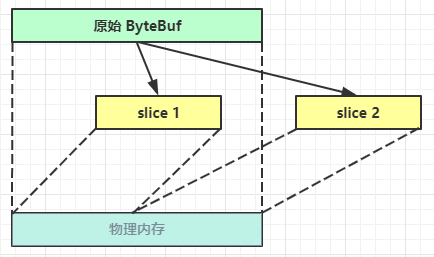
例,原始 ByteBuf 进行一些初始操作
ByteBuf origin = ByteBufAllocator.DEFAULT.buffer(10);
origin.writeBytes(new byte[]{1, 2, 3, 4});
origin.readByte();
System.out.println(ByteBufUtil.prettyHexDump(origin));
输出
+-------------------------------------------------+
| 0 1 2 3 4 5 6 7 8 9 a b c d e f |
+--------+-------------------------------------------------+----------------+
|00000000| 02 03 04 |... |
+--------+-------------------------------------------------+----------------+
这时调用 slice 进行切片,无参 slice 是从原始 ByteBuf 的 read index 到 write index 之间的内容进行切片,切片后的 max capacity 被固定为这个区间的大小,因此不能追加 write
ByteBuf slice = origin.slice();
System.out.println(ByteBufUtil.prettyHexDump(slice));
// slice.writeByte(5); 如果执行,会报 IndexOutOfBoundsException 异常,切片后不能写入
输出
+-------------------------------------------------+
| 0 1 2 3 4 5 6 7 8 9 a b c d e f |
+--------+-------------------------------------------------+----------------+
|00000000| 02 03 04 |... |
+--------+-------------------------------------------------+----------------+
如果原始 ByteBuf 再次读操作(又读了一个字节)
origin.readByte();
System.out.println(ByteBufUtil.prettyHexDump(origin));
输出
+-------------------------------------------------+
| 0 1 2 3 4 5 6 7 8 9 a b c d e f |
+--------+-------------------------------------------------+----------------+
|00000000| 03 04 |.. |
+--------+-------------------------------------------------+----------------+
这时的 slice 不受影响,因为它有独立的读写指针
System.out.println(ByteBufUtil.prettyHexDump(slice));
输出
+-------------------------------------------------+
| 0 1 2 3 4 5 6 7 8 9 a b c d e f |
+--------+-------------------------------------------------+----------------+
|00000000| 02 03 04 |... |
+--------+-------------------------------------------------+----------------+
如果 slice 的内容发生了更改
slice.setByte(2, 5);
System.out.println(ByteBufUtil.prettyHexDump(slice));
输出
+-------------------------------------------------+
| 0 1 2 3 4 5 6 7 8 9 a b c d e f |
+--------+-------------------------------------------------+----------------+
|00000000| 02 03 05 |... |
+--------+-------------------------------------------------+----------------+
这时,原始 ByteBuf 也会受影响,因为底层都是同一块内存
System.out.println(ByteBufUtil.prettyHexDump(origin));
输出
+-------------------------------------------------+
| 0 1 2 3 4 5 6 7 8 9 a b c d e f |
+--------+-------------------------------------------------+----------------+
|00000000| 03 05 |.. |
+--------+-------------------------------------------------+----------------+
结合retain使用
slice出切片后,最好使用retain进行引用计数+1。因为在别处如果buf被释放,会导致在使用切片时报错。
package cn.itcast.netty.c4;
import io.netty.buffer.ByteBuf;
import io.netty.buffer.ByteBufAllocator;
import static cn.itcast.netty.c4.TestByteBuf.log;
public class TestSlice {
public static void main(String[] args) {
ByteBuf buf = ByteBufAllocator.DEFAULT.buffer(10);
buf.writeBytes(new byte[]{'a','b','c','d','e','f','g','h','i','j'});
log(buf);
// 在切片过程中,没有发生数据复制
ByteBuf f1 = buf.slice(0, 5);
f1.retain(); //引用计数+1,以防buf被释放后,slice无法使用
// 'a','b','c','d','e', 'x'
ByteBuf f2 = buf.slice(5, 5);
f2.retain(); //引用计数+1
log(f1);
log(f2);
System.out.println("释放原有 byteBuf 内存");
buf.release();
log(f1);
f1.release();
f2.release();
/*System.out.println("========================");
f1.setByte(0, 'b');
log(f1);
log(buf);*/
}
}
结果:
read index:0 write index:10 capacity:10
+-------------------------------------------------+
| 0 1 2 3 4 5 6 7 8 9 a b c d e f |
+--------+-------------------------------------------------+----------------+
|00000000| 61 62 63 64 65 66 67 68 69 6a |abcdefghij |
+--------+-------------------------------------------------+----------------+
read index:0 write index:5 capacity:5
+-------------------------------------------------+
| 0 1 2 3 4 5 6 7 8 9 a b c d e f |
+--------+-------------------------------------------------+----------------+
|00000000| 61 62 63 64 65 |abcde |
+--------+-------------------------------------------------+----------------+
read index:0 write index:5 capacity:5
+-------------------------------------------------+
| 0 1 2 3 4 5 6 7 8 9 a b c d e f |
+--------+-------------------------------------------------+----------------+
|00000000| 66 67 68 69 6a |fghij |
+--------+-------------------------------------------------+----------------+
释放原有 byteBuf 内存
read index:0 write index:5 capacity:5
+-------------------------------------------------+
| 0 1 2 3 4 5 6 7 8 9 a b c d e f |
+--------+-------------------------------------------------+----------------+
|00000000| 61 62 63 64 65 |abcde |
+--------+-------------------------------------------------+----------------+
Process finished with exit code 0
10)duplicate
【零拷贝】的体现之一,就好比截取了原始 ByteBuf 所有内容,并且没有 max capacity 的限制,也是与原始 ByteBuf 使用同一块底层内存,只是读写指针是独立的
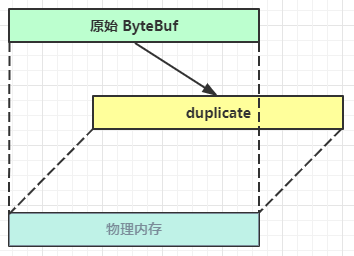
11)copy
会将底层内存数据进行深拷贝,因此无论读写,都与原始 ByteBuf 无关
12)CompositeByteBuf
【零拷贝】的体现之一,可以将多个 ByteBuf 合并为一个逻辑上的 ByteBuf,避免拷贝
有两个 ByteBuf 如下
ByteBuf buf1 = ByteBufAllocator.DEFAULT.buffer(5);
buf1.writeBytes(new byte[]{1, 2, 3, 4, 5});
ByteBuf buf2 = ByteBufAllocator.DEFAULT.buffer(5);
buf2.writeBytes(new byte[]{6, 7, 8, 9, 10});
System.out.println(ByteBufUtil.prettyHexDump(buf1));
System.out.println(ByteBufUtil.prettyHexDump(buf2));
输出
+-------------------------------------------------+
| 0 1 2 3 4 5 6 7 8 9 a b c d e f |
+--------+-------------------------------------------------+----------------+
|00000000| 01 02 03 04 05 |..... |
+--------+-------------------------------------------------+----------------+
+-------------------------------------------------+
| 0 1 2 3 4 5 6 7 8 9 a b c d e f |
+--------+-------------------------------------------------+----------------+
|00000000| 06 07 08 09 0a |..... |
+--------+-------------------------------------------------+----------------+
现在需要一个新的 ByteBuf,内容来自于刚才的 buf1 和 buf2,如何实现?
方法1:
ByteBuf buf3 = ByteBufAllocator.DEFAULT
.buffer(buf1.readableBytes()+buf2.readableBytes());
buf3.writeBytes(buf1);
buf3.writeBytes(buf2);
System.out.println(ByteBufUtil.prettyHexDump(buf3));
结果
+-------------------------------------------------+
| 0 1 2 3 4 5 6 7 8 9 a b c d e f |
+--------+-------------------------------------------------+----------------+
|00000000| 01 02 03 04 05 06 07 08 09 0a |.......... |
+--------+-------------------------------------------------+----------------+
这种方法好不好?回答是不太好,因为进行了数据的内存复制操作
方法2:
CompositeByteBuf buf3 = ByteBufAllocator.DEFAULT.compositeBuffer();
// true 表示增加新的 ByteBuf 自动递增 write index, 否则 write index 会始终为 0
buf3.addComponents(true, buf1, buf2);
结果是一样的
+-------------------------------------------------+
| 0 1 2 3 4 5 6 7 8 9 a b c d e f |
+--------+-------------------------------------------------+----------------+
|00000000| 01 02 03 04 05 06 07 08 09 0a |.......... |
+--------+-------------------------------------------------+----------------+
CompositeByteBuf 是一个组合的 ByteBuf,它内部维护了一个 Component 数组,每个 Component 管理一个 ByteBuf,记录了这个 ByteBuf 相对于整体偏移量等信息,代表着整体中某一段的数据。
- 优点,对外是一个虚拟视图,组合这些 ByteBuf 不会产生内存复制
- 缺点,复杂了很多,多次操作会带来性能的损耗
13)Unpooled
Unpooled 是一个工具类,类如其名,提供了非池化的 ByteBuf 创建、组合、复制等操作
这里仅介绍其跟【零拷贝】相关的 wrappedBuffer 方法,可以用来包装 ByteBuf
ByteBuf buf1 = ByteBufAllocator.DEFAULT.buffer(5);
buf1.writeBytes(new byte[]{1, 2, 3, 4, 5});
ByteBuf buf2 = ByteBufAllocator.DEFAULT.buffer(5);
buf2.writeBytes(new byte[]{6, 7, 8, 9, 10});
// 当包装 ByteBuf 个数超过一个时, 底层使用了 CompositeByteBuf
ByteBuf buf3 = Unpooled.wrappedBuffer(buf1, buf2);
System.out.println(ByteBufUtil.prettyHexDump(buf3));
输出
+-------------------------------------------------+
| 0 1 2 3 4 5 6 7 8 9 a b c d e f |
+--------+-------------------------------------------------+----------------+
|00000000| 01 02 03 04 05 06 07 08 09 0a |.......... |
+--------+-------------------------------------------------+----------------+
也可以用来包装普通字节数组,底层也不会有拷贝操作
ByteBuf buf4 = Unpooled.wrappedBuffer(new byte[]{1, 2, 3}, new byte[]{4, 5, 6});
System.out.println(buf4.getClass());
System.out.println(ByteBufUtil.prettyHexDump(buf4));
输出
class io.netty.buffer.CompositeByteBuf
+-------------------------------------------------+
| 0 1 2 3 4 5 6 7 8 9 a b c d e f |
+--------+-------------------------------------------------+----------------+
|00000000| 01 02 03 04 05 06 |...... |
+--------+-------------------------------------------------+----------------+
ByteBuf 优势
- 池化 - 可以重用池中 ByteBuf 实例,更节约内存,减少内存溢出的可能
- 读写指针分离,不需要像 ByteBuffer 一样切换读写模式
- 可以自动扩容
- 支持链式调用,使用更流畅
- 很多地方体现零拷贝,例如 slice、duplicate、CompositeByteBuf
4. 双向通信
4.1 练习(与Netty实战中那个实例一样)
实现一个 echo server
编写 server
package cn.itcast.netty.c5;
import io.netty.bootstrap.ServerBootstrap;
import io.netty.buffer.ByteBuf;
import io.netty.channel.ChannelHandlerContext;
import io.netty.channel.ChannelInboundHandlerAdapter;
import io.netty.channel.ChannelInitializer;
import io.netty.channel.nio.NioEventLoopGroup;
import io.netty.channel.socket.nio.NioServerSocketChannel;
import io.netty.channel.socket.nio.NioSocketChannel;
import java.nio.charset.Charset;
public class EchoServer {
public static void main(String[] args) {
new ServerBootstrap()
.group(new NioEventLoopGroup())
.channel(NioServerSocketChannel.class)
.childHandler(new ChannelInitializer<NioSocketChannel>() {
@Override
protected void initChannel(NioSocketChannel ch) {
ch.pipeline().addLast(new ChannelInboundHandlerAdapter(){
@Override
public void channelRead(ChannelHandlerContext ctx, Object msg) {
ByteBuf buffer = (ByteBuf) msg;
System.out.println(buffer.toString(Charset.defaultCharset()));
// 建议使用 ctx.alloc() 创建 ByteBuf
ByteBuf response = ctx.alloc().buffer();
response.writeBytes(buffer);
ctx.writeAndFlush(response);
// 思考:需要释放 buffer 吗
// 思考:需要释放 response 吗
}
});
}
}).bind(8080);
}
}
编写 client
package cn.itcast.netty.c5;
import io.netty.bootstrap.Bootstrap;
import io.netty.buffer.ByteBuf;
import io.netty.channel.Channel;
import io.netty.channel.ChannelHandlerContext;
import io.netty.channel.ChannelInboundHandlerAdapter;
import io.netty.channel.ChannelInitializer;
import io.netty.channel.nio.NioEventLoopGroup;
import io.netty.channel.socket.nio.NioSocketChannel;
import io.netty.handler.codec.string.StringDecoder;
import io.netty.handler.codec.string.StringEncoder;
import java.nio.charset.Charset;
import java.util.Scanner;
public class EchoClient {
public static void main(String[] args) throws InterruptedException {
NioEventLoopGroup group = new NioEventLoopGroup();
Channel channel = new Bootstrap()
.group(group)
.channel(NioSocketChannel.class)
.handler(new ChannelInitializer<NioSocketChannel>() {
@Override
protected void initChannel(NioSocketChannel ch) throws Exception {
ch.pipeline().addLast(new StringEncoder());
ch.pipeline().addLast(new ChannelInboundHandlerAdapter() {
@Override
public void channelRead(ChannelHandlerContext ctx, Object msg) throws Exception {
ByteBuf buffer = (ByteBuf) msg;
System.out.println(buffer.toString(Charset.defaultCharset()));
// 思考:需要释放 buffer 吗
}
});
}
}).connect("127.0.0.1", 8080).sync().channel();
channel.closeFuture().addListener(future -> {
group.shutdownGracefully();
});
new Thread(() -> {
Scanner scanner = new Scanner(System.in);
while (true) {
String line = scanner.nextLine();
if ("q".equals(line)) {
channel.close();
break;
}
channel.writeAndFlush(line);
}
}).start();
}
}
读和写的误解
最初在认识上有这样的误区,认为只有在 netty,nio 这样的多路复用 IO 模型时,读写才不会相互阻塞,才可以实现高效的双向通信,但实际上,Java Socket 是全双工的:在任意时刻,线路上存在A 到 B 和 B 到 A 的双向信号传输。即使是阻塞 IO,读和写是可以同时进行的,只要分别采用读线程和写线程即可,读不会阻塞写、写也不会阻塞读
例如
public class TestServer {
public static void main(String[] args) throws IOException {
ServerSocket ss = new ServerSocket(8888);
Socket s = ss.accept();
new Thread(() -> {
try {
BufferedReader reader = new BufferedReader(new InputStreamReader(s.getInputStream()));
while (true) {
System.out.println(reader.readLine());
}
} catch (IOException e) {
e.printStackTrace();
}
}).start();
new Thread(() -> {
try {
BufferedWriter writer = new BufferedWriter(new OutputStreamWriter(s.getOutputStream()));
// 例如在这个位置加入 thread 级别断点,可以发现即使不写入数据,也不妨碍前面线程读取客户端数据
for (int i = 0; i < 100; i++) {
writer.write(String.valueOf(i));
writer.newLine();
writer.flush();
}
} catch (IOException e) {
e.printStackTrace();
}
}).start();
}
}
客户端
public class TestClient {
public static void main(String[] args) throws IOException {
Socket s = new Socket("localhost", 8888);
new Thread(() -> {
try {
BufferedReader reader = new BufferedReader(new InputStreamReader(s.getInputStream()));
while (true) {
System.out.println(reader.readLine());
}
} catch (IOException e) {
e.printStackTrace();
}
}).start();
new Thread(() -> {
try {
BufferedWriter writer = new BufferedWriter(new OutputStreamWriter(s.getOutputStream()));
for (int i = 0; i < 100; i++) {
writer.write(String.valueOf(i));
writer.newLine();
writer.flush();
}
} catch (IOException e) {
e.printStackTrace();
}
}).start();
}
}
【Netty】02-入门的更多相关文章
- Netty快速入门(02)Java I/O(BIO)介绍
BIO简介 Java I/O,也叫Blocking I/O,也就是阻塞式I/O. BIO的流程比较简单,在服务端创立一个ServerSocket去监听,等待连接.客户端创建一个Socket连接过来,服 ...
- 关于Netty的入门使用
Netty介绍: Netty是一个提供异步事件驱动的网络应用框架,用以快速开发高性能.高可靠性的网络服务器和客户端程序. 换句话说,Netty是一个NIO框架,使用它可以简单快速地开发网络应用程序,比 ...
- Netty快速入门(08)ByteBuf组件介绍
前面的内容对netty进行了介绍,写了一个入门例子.作为一个netty的使用者,我们关注更多的还是业务代码.也就是netty中这两种组件: ChannelHandler和ChannelPipeline ...
- Netty快速入门(09)channel组件介绍
书接上回,继续介绍组件. ChannelHandler组件介绍 ChannelHandler组件包含了业务处理核心逻辑,是由用户自定义的内容,开发人员百分之九十的代码都是ChannelHandler. ...
- netty的入门
netty是什么? netty是一个基于NIO的通信框架,对于传统计算机,系统的瓶颈一直在输入输出设备上,计算速度超过IO速度,所以对于i o的性能提高异常重要. 什么是NIO? 非阻塞IO,N表示n ...
- [笨木头FireFly 02]入门篇2_客户端发送请求,服务器处理请求
原地址:http://www.9miao.com/question-15-53940.html 好,经过上一篇不权威的讲解,大家已经能轻易地让客户端和服务端连接起来了. 但是,仅仅是连接了,可它们俩不 ...
- 1、Netty 实战入门详解
一.Netty 简介 Netty 是基于 Java NIO 的异步事件驱动的网络应用框架,使用 Netty 可以快速开发网络应用,Netty 提供了高层次的抽象来简化 TCP 和 UDP 服务器的编程 ...
- Netty从入门到精通到放弃
有时间想记录一下关于Netty的知识. 第一课:传统IO的特点. package com.example.aimei.controller; import java.io.InputStream; i ...
- Netty框架入门
一.概述 Netty是由JBOSS提供的一个java开源框架. Netty提供异步的.事件驱动的网络应用程序框架和工具,用以快速开发高性能.高可靠性的网络服务器和客户端程序. 二. ...
- 网络应用框架Netty快速入门
一 初遇Netty Netty是什么? Netty 是一个提供 asynchronous event-driven (异步事件驱动)的网络应用框架,是一个用以快速开发高性能.可扩展协议的服务器和客户端 ...
随机推荐
- MQ(消息队列)常见问题梳理
MQ 中 broker 的作用,有无broker有什么差异? MQ(Message Queue)中的broker是消息队列的核心组件之一,它的作用是接收.存储.分发和传递消息.具体来说,broker主 ...
- 垃圾回收之三色标记法(Tri-color Marking)
关于垃圾回收算法,基本就是那么几种:标记-清除.标记-复制.标记-整理.在此基础上可以增加分代(新生代/老年代),每代采取不同的回收算法,以提高整体的分配和回收效率. 无论使用哪种算法,标记总是必要的 ...
- SpringBoot中如何实现业务校验,这种方式才叫优雅!
大家好,我是飘渺. 在日常的接口开发中,为了保证接口的稳定安全,我们一般需要在接口逻辑中处理两种校验: 参数校验 业务规则校验 首先我们先看看参数校验. 参数校验 参数校验很好理解,比如登录的时候需要 ...
- Python集合常用操作
一.集合的介绍 1.定义:集合是无序的,集合中的元素是唯一的,集合一般用于元组或者列表中的元素去重. 2.特性:集合的目的是将不同的值存放在一起,不同的集合间用来做关系运算,无须纠结于集合中的 ...
- [人生感悟]做人、做事的"人生十悟"【转载】
做人.做事.做官,是不少人需要经常面对和正确把握的大问题,处理好了,则健康成长,反之则裹足不前,甚至掉入人生的一个个"陷阱",这其中有规律可循,总结"十悟"可思 ...
- py文件转换为so文件
将py文件编译为so文件 利用上面代码生成so文件生成的文件不方便取放,名字也不一样 通过执行发现转换执行了下面三句 /usr/local/python3/bin/cython test.py gcc ...
- 23.04.06_为博客设置https
title: 为博客设置https协议 categories: - 博客优化 date: 2023-04-06 url_dir: Blog_optimization url_name: setting ...
- mysql数据库常见优化方法
1,创建适当的索引(主键索引.唯一索引.普通索引.全文索引.空间索引). 2,对sql语句进行优化--->慢查询(explain). 3,使用分表技术(水平分表,垂直分表),分区技术. 4,读写 ...
- 发现Mysql的主从数据库没有同步,差点凉凉了
摘要:今天发现Mysql的主从数据库没有同步,瞬间整个人头皮发麻. 本文分享自华为云社区<糟了,生产环境数据竟然不一致,人麻了!>,作者:冰 河 . 今天发现Mysql的主从数据库没有同步 ...
- 关于Validation的方法使用
acceptance验证 acceptance 是 Rails 中的一个验证器(validator),用于验证一个布尔类型的属性是否被接受.在表单中,通常会有一些复选框或单选按钮,用户需要勾选或选择才 ...
